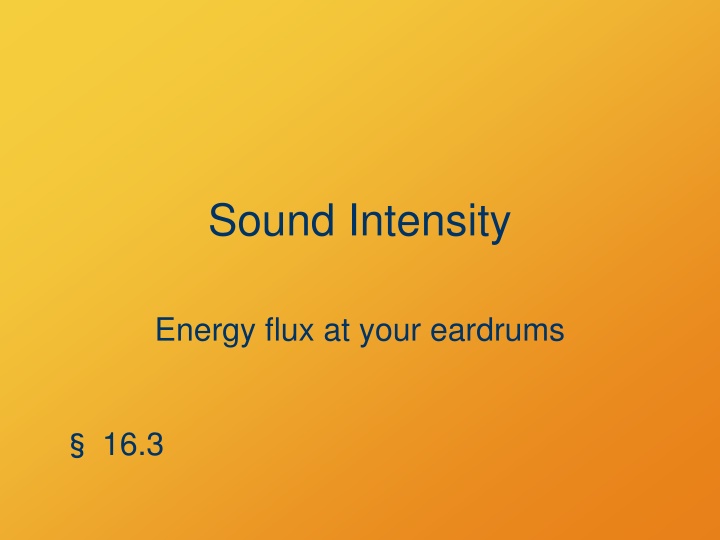
Sound Intensity and Longitudinal Waves
Explore the concepts of sound intensity, energy flux, and longitudinal waves. Learn about the inverse-square law, decibel scale, and how sound intensity levels change with distance. Dive into the properties of longitudinal waves and understand particle acceleration and speed in wave oscillations.
Download Presentation

Please find below an Image/Link to download the presentation.
The content on the website is provided AS IS for your information and personal use only. It may not be sold, licensed, or shared on other websites without obtaining consent from the author. If you encounter any issues during the download, it is possible that the publisher has removed the file from their server.
You are allowed to download the files provided on this website for personal or commercial use, subject to the condition that they are used lawfully. All files are the property of their respective owners.
The content on the website is provided AS IS for your information and personal use only. It may not be sold, licensed, or shared on other websites without obtaining consent from the author.
E N D
Presentation Transcript
Sound Intensity Energy flux at your eardrums 16.3
Sound Intensity I = (Power output)/(Area) = (Force) (Displacement velocity)/(Area) = (Force/Area) (Displacement velocity) = (Pressure) (Displacement velocity) = p(x,t) vy(x,t)
Intensity and Distance Inverse-square law: Source transmits power P At distance R, energy is spread over area A = 4 R2 Intensity at distance R is P/A P IR = 4 R2
Sound Intensity Level Decibel scale I = (10 dB) log10I0 Reference intensity I0 = 10 12 W/m2 Audibility threshold at 1000 Hz A 10-dB increase in intensity level represents a factor-of-10 increase in sound intensity
Decibel Differences I = (10 dB) log10I0 I2 2 1 = (10 dB) log10I1 R12 R22 R1 R2 = (10 dB) log10 = (20 dB) log10
Example Problem 30 m from an outdoor concert stage, the sound intensity level is 80 dB. What is the sound intensity level 40 m from the stage? 2 1 = (20 dB) log10(R1/R2) 2 = 1 + (20 dB) log10(R1/R2) = 80 dB + (20 dB) log10(30/40) = 80 dB + (20 dB) ( 0.125) = 80 dB 2.50 dB = 77.5 dB
Longitudinal Waves 16.1
Group Poll For any wave/oscillation: What is the particle acceleration when the particle speed is greatest? A. Maximum. B. Zero. C. ? What is the particle speed when the particle acceleration is greatest? A. Maximum. B. Zero. C. ?
Longitudinal Waves 0 1/8 T 2/8 T 3/8 T 4/8 T 5/8 T 6/8 T 7/8 T Where are crests and troughs? Which way is acceleration?
Board Work Draw several cycles of a longitudinal wave train. What force accelerates the particles? Identify where pressure is high or low. Identify the acceleration directions at different positions along a phase.
Group Poll For a sound wave: What is the pressure excursion where the particle acceleration is greatest? A. Maximum. B. Zero. C. ? What is the particle acceleration where the pressure excursion is greatest? A. Maximum. B. Zero. C. ?
End Result Pressure is 90 out of phase with displacement Pressure is greatest when forward velocity is greatest Pressure is least when backward velocity is greatest
